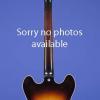A Fine and Super Rare 1964 Factory Bigsby SG Standard
This 13-inch-wide SG Standard weighs just 6.80 lbs. and has a nice, fat nut width of 1 11/16 inches and a standard Gibson scale length of 24 3/4 inches. Solid Honduras mahogany body with bevelled edges, one-piece mahogany neck, and rosewood fretboard with 22 medium jumbo frets and inlaid pearl trapezoid position markers. Headstock with inlaid pearl "Gibson" logo and pearl crown inlay. Individual single-line Kluson Deluxe tuners with double-ring Keystone plastic "Tulip" buttons. Serial number ("189649") stamped on the back of the headstock. Two original Gibson patent-number humbucker pickups, each with a black label ("Patent No 2,737,842") on the underside, with outputs of 7.38k and 7.19k. Original "MR 491" and "MR 490" black pickup rings. Four-layer (black/white/black/white) plastic pickguard. Four controls (two volume, two tone) plus three-way selector switch, all on lower treble bout. Potentiometers stamped "137 64--" (CTS [month obscured by solder on all four pots] 1964). Black plastic bell-shaped knobs with metal tops. ABR-1 Tune-O-Matic retainer bridge with nylon saddles and super rare factory Bigsby vibrato with short arm. Apart from a minuscule amount of belt buckle scarring on the back of the guitar, a small area of wear (from the player's body) on the bass edge of the bevel, and another tiny area of wear (from resting on the player's leg) on the treble edge, this totally original and completely unfaded example is in near mint (9.25) condition. It has one of the best and fattest '64 necks that we have ever seen -- absolutely to die for -- and we all know that the factory-order Bigsby tailpiece is the next best thing to a stop-tail…Housed in the original Gibson deluxe black "faultless" hardshell case with orange plush lining (9.00).
At 6.80 lbs. this guitar is also the lightest SG Standard that we have ever seen -- the eight others that we have handled over the past few years ranged from 7.20 to 7.60 lbs.
On this guitar, the Bigsby is correctly (factory) positioned (with the lower edge of the Bigsby just over 2 3/4 inches above the lower edge of the guitar), as on the 1962 Cherry Red Short Bigsby SG Standard on p. 192 in Norman Harris, Norman's Rare Guitars: 30 Years of Buying, Selling and Collecting, rather than just above the lower edge of the guitar, as is often seen on "so-called" factory Bigsbys, where the screw holes for the original Gibson Lyre Vibrola were covered.
"Considering all the Les Paul models as a whole, sales declined in 1960 after a peak in 1959...[and] by 1961 Gibson had decided on a complete re-design of the line in an effort to reactivate this faltering model. The company had started a $400,000 expansion of the factory in Kalamazoo during 1960 which more than doubled the size of the plant by the time it was completed in 1961...One of the first series of new models to benefit from the company's newly expanded production facilities was the completely revised line of Les Paul models. Gibson redesigned the Junior, Standard and Custom models, adopting a new, distinctly modern, sculpted double-cutaway design. The 'Les Paul' name was still used at first, but during 1963 Gibson began to call these new models the SG Junior, the SG Standard and the SG Custom...The transition models -- those produced between 1961 and 1963 -- had the new SG design but the old Les Paul names, and these are now known to collectors and players as SG/Les Paul models...SG-style solidbodies have attracted a number of players over the years, including John Cipollina, Eric Clapton, Tony Iommi, Robbie Krieger, Tony McPhee, Pete Townshend, Angus Young and Frank Zappa" (Tony Bacon, Electric Guitars: The Illustrated Encyclopedia, pp. 134-136).
Translate:

